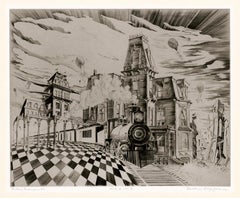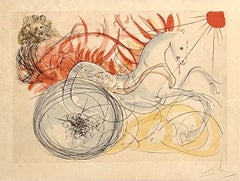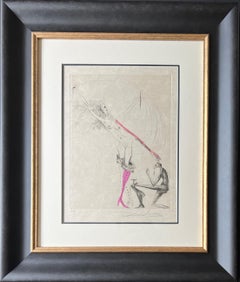Lawrence Kupferman Figurative Prints
Lawrence Kupferman was born in the Boston area, and he became one of the most important abstract artists to emerge from there in the early 1940s. Kupferman worked as an artist for the WPA in the 1930s, developing a strictly realistic style that depicted Victorian houses and other detailed architectural images.
Around 1943, Kupferman began to integrate more expressionistic forms into his works. He soon moved completely away from the recognizable subject matter and definitively became an abstract painter. In 1946, he studied with the influential German-born artist Karl Zerbe at the School of the Museum of Fine Arts in Boston. Kupferman later attended the Massachusetts College of Art, where he would become a professor and retire as its Head of Painting in 1969. His focus, as it would remain until the late 1960s, was on abstract, marine-like amoeboid forms—intimated, rather than strictly described.
Kupferman was an active participant in a huge thrust in Boston art in the 1940s to create a vibrant art scene that rivaled New York. He has been appropriately credited with bringing Abstract Expressionism to Boston, serving as a critical artistic conduit to New York painters such as Mark Rothko and Hans Hofmann, contacts he made in Provincetown, Massachusetts, where he spent his summers beginning in 1946. Kupferman’s unique brand of abstraction integrated with the already burgeoning figurative expressionism in Boston, and he showed at the Boris Mirksi Gallery, arguably the most important Boston gallery at the time. He served as the Chair of the Modern Artists Group and is considered one of the major Boston artists whose numerous exhibitions throughout the world helped establish that city as a vital art scene.
1940s Surrealist Lawrence Kupferman Figurative Prints
Drypoint, Etching
1970s Surrealist Lawrence Kupferman Figurative Prints
Drypoint, Etching, Lithograph
1960s Surrealist Lawrence Kupferman Figurative Prints
Watercolor, Paper, Drypoint, Etching
1970s Surrealist Lawrence Kupferman Figurative Prints
Drypoint, Etching
1970s Surrealist Lawrence Kupferman Figurative Prints
Drypoint, Aquatint
1970s Surrealist Lawrence Kupferman Figurative Prints
Drypoint, Aquatint
1970s Surrealist Lawrence Kupferman Figurative Prints
Drypoint, Aquatint
1970s Surrealist Lawrence Kupferman Figurative Prints
Drypoint, Etching
1970s Surrealist Lawrence Kupferman Figurative Prints
Drypoint, Aquatint
1970s Surrealist Lawrence Kupferman Figurative Prints
Drypoint, Aquatint
1920s Surrealist Lawrence Kupferman Figurative Prints
Drypoint, Etching
1970s Surrealist Lawrence Kupferman Figurative Prints
Drypoint, Aquatint
20th Century Surrealist Lawrence Kupferman Figurative Prints
Drypoint, Etching
1940s American Realist Lawrence Kupferman Figurative Prints
Drypoint



